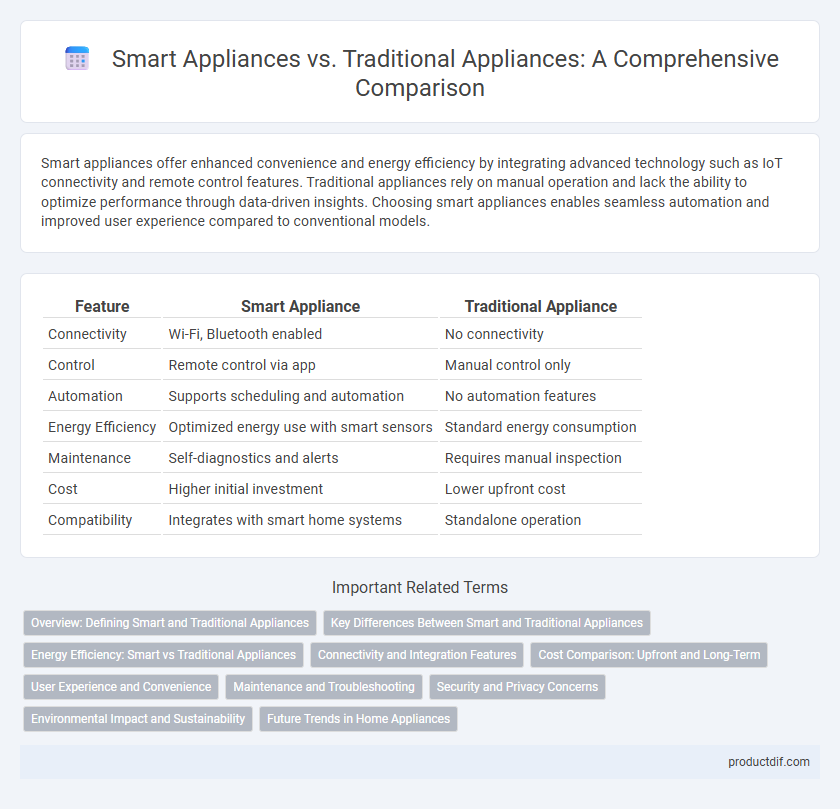Smart appliances offer enhanced convenience and energy efficiency by integrating advanced technology such as IoT connectivity and remote control features. Traditional appliances rely on manual operation and lack the ability to optimize performance through data-driven insights. Choosing smart appliances enables seamless automation and improved user experience compared to conventional models.
Table of Comparison
| Feature | Smart Appliance | Traditional Appliance |
|---|---|---|
| Connectivity | Wi-Fi, Bluetooth enabled | No connectivity |
| Control | Remote control via app | Manual control only |
| Automation | Supports scheduling and automation | No automation features |
| Energy Efficiency | Optimized energy use with smart sensors | Standard energy consumption |
| Maintenance | Self-diagnostics and alerts | Requires manual inspection |
| Cost | Higher initial investment | Lower upfront cost |
| Compatibility | Integrates with smart home systems | Standalone operation |
Overview: Defining Smart and Traditional Appliances
Smart appliances integrate advanced technologies such as Wi-Fi connectivity, sensors, and AI to enable remote control, automation, and energy efficiency, contrasting with traditional appliances that operate through manual controls and fixed functions. These intelligent devices offer real-time monitoring and adaptive performance, optimizing household convenience and sustainability. Traditional appliances rely on mechanical or basic electronic components, lacking remote access and adaptive features.
Key Differences Between Smart and Traditional Appliances
Smart appliances offer advanced features such as remote control, automation, and energy efficiency, leveraging IoT technology for enhanced convenience and performance. Traditional appliances operate with basic manual controls and lack connectivity, resulting in limited functionality and higher energy consumption. Integration of sensors and Wi-Fi in smart appliances enables real-time monitoring and predictive maintenance, which traditional models do not support.
Energy Efficiency: Smart vs Traditional Appliances
Smart appliances significantly outperform traditional appliances in energy efficiency by utilizing advanced sensors and connectivity to optimize power consumption in real time. Unlike traditional models that operate at fixed power levels regardless of usage, smart appliances adjust their energy usage based on demand, reducing waste and lowering utility bills. Studies indicate that smart appliances can reduce household energy consumption by up to 30%, making them a cost-effective and environmentally friendly option.
Connectivity and Integration Features
Smart appliances offer advanced connectivity through Wi-Fi and Bluetooth, enabling remote control and monitoring via smartphone apps, unlike traditional appliances that typically lack internet access. These devices integrate seamlessly with smart home ecosystems, supporting voice assistants like Amazon Alexa and Google Assistant for enhanced user convenience. Traditional appliances operate independently without integration capabilities, limiting automation and real-time status updates.
Cost Comparison: Upfront and Long-Term
Smart appliances often have higher upfront costs ranging from 20% to 50% more than traditional appliances due to advanced connectivity and integrated sensors. Long-term expenses can be lower with smart appliances through energy-efficient features, automatic maintenance alerts, and remote diagnostics reducing repair and utility costs. Traditional appliances typically require less initial investment but may incur higher operating and maintenance costs over a product lifecycle of 10 to 15 years.
User Experience and Convenience
Smart appliances enhance user experience by offering remote control, automated functions, and real-time monitoring through mobile apps, increasing convenience and efficiency. Traditional appliances lack connectivity features, requiring manual operation and limiting customization options. Integration with smart home ecosystems provides seamless interaction, energy optimization, and personalized settings beyond the capabilities of conventional models.
Maintenance and Troubleshooting
Smart appliances feature advanced diagnostic tools that enable proactive maintenance by alerting users to potential issues before they escalate, reducing downtime and costly repairs. Traditional appliances typically require manual inspection and troubleshooting, often leading to longer repair times and higher maintenance expenses. Integration of IoT in smart appliances streamlines remote troubleshooting, allowing technicians to resolve problems efficiently without on-site visits.
Security and Privacy Concerns
Smart appliances incorporate advanced connectivity features, enabling remote control and real-time data collection, which introduces potential vulnerabilities to hacking and unauthorized access. Traditional appliances, lacking internet connectivity, minimize risks related to data breaches and privacy invasion. However, smart appliances require robust encryption protocols and regular firmware updates to mitigate security threats and protect sensitive user information effectively.
Environmental Impact and Sustainability
Smart appliances significantly reduce energy consumption by optimizing usage patterns and utilizing advanced sensors, lowering overall carbon dioxide emissions compared to traditional appliances. These devices support sustainability through remote monitoring and adaptive controls that minimize waste and prolong appliance lifespan. Traditional appliances generally lack these efficiencies, resulting in higher electricity use and greater environmental impact over their operational life.
Future Trends in Home Appliances
Smart appliances are revolutionizing the future of home automation by integrating Internet of Things (IoT) technology, enabling remote control and predictive maintenance through AI algorithms. Traditional appliances lack connectivity features, which limits energy efficiency and user customization, making smart models more appealing for sustainable living. Advances in machine learning and voice recognition continue to drive the evolution of smart appliances, fostering smarter, energy-saving homes.
Smart Appliance vs Traditional Appliance Infographic

 productdif.com
productdif.com